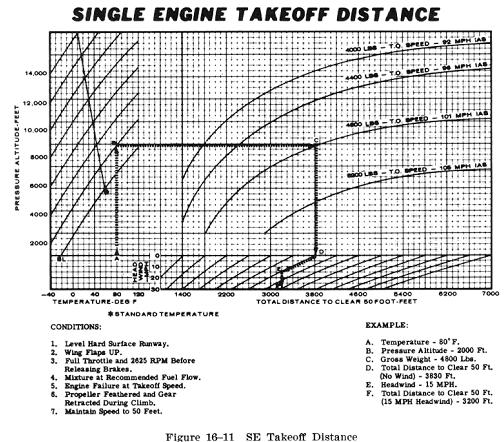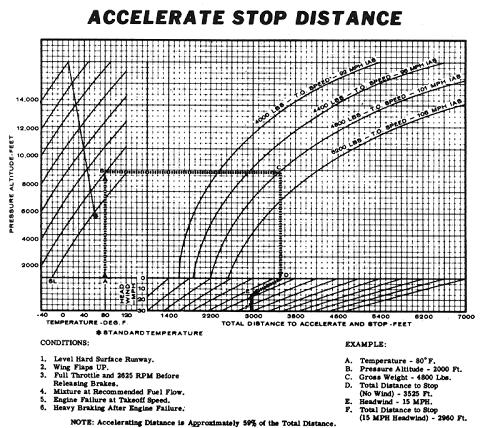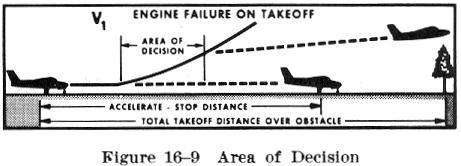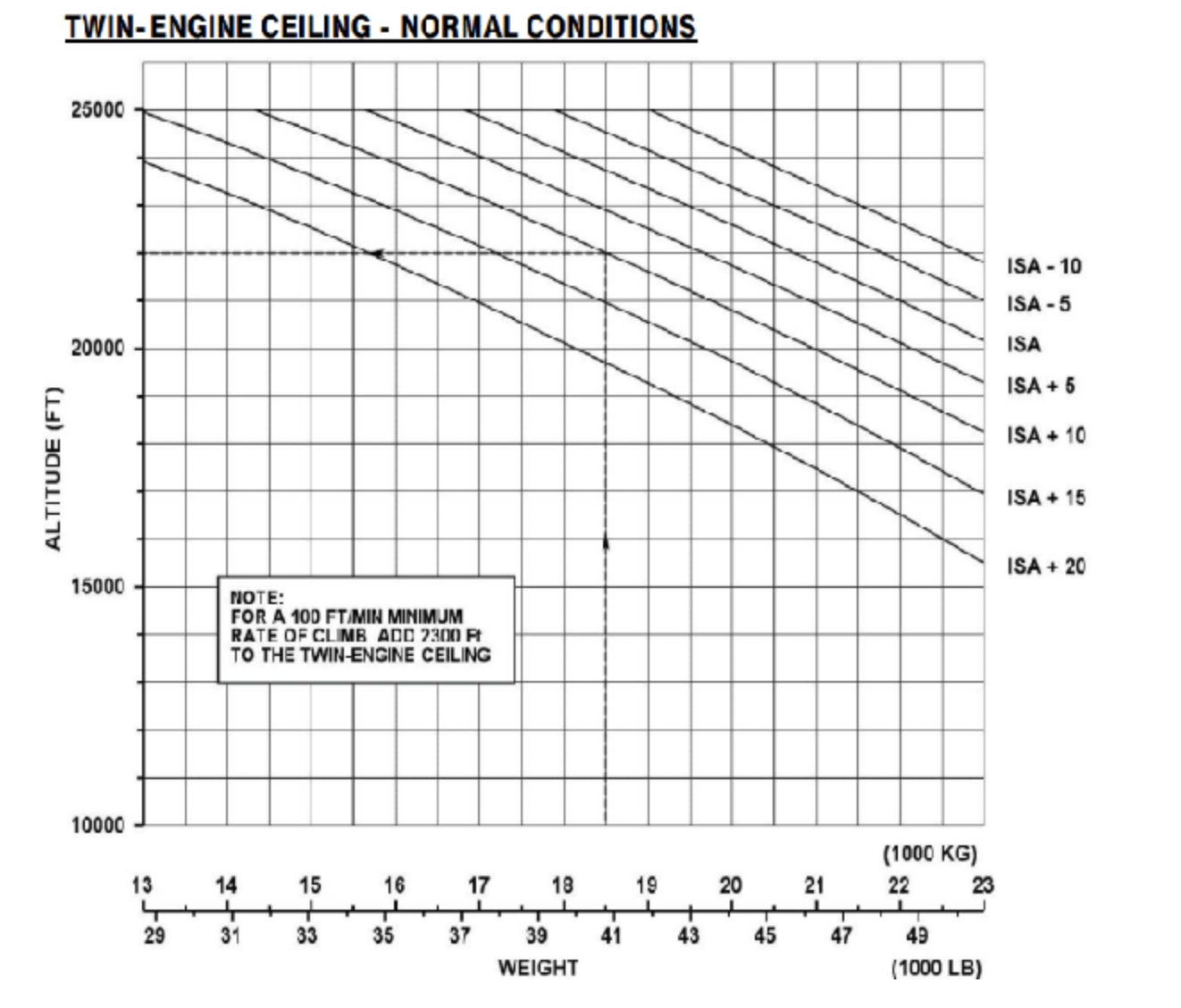In Multi-Engine Aerodynamics, I touched on the subject of one engine inoperative (OEI) performance. In addition, I described how factors affecting Vmc are often inversely correlated with performance. Lastly, I quantified what loss in performance can be expected with one engine inoperative.
An engine failure results
in a loss of:
50%
of power
80%+
of performance
Given this, what are the practical considerations for the Pilot in Command regarding engine failures during takeoff and while en-route?
Takeoff and Landing
- Can the airplane be stopped on the runway?
- Can the airplane clear obstacles at the current density altitude and weight?
En-route
- What altitude can the airplane maintain with one engine inoperative.
Performance Distances
- Accelerate-Stop Distance: The distance required to accelerate to Vr, experience an engine failure and come to a stop. Prior to every flight, ensure this distance is less than the runway available.
- Accelerate-Go Distance: The distance required to accelerate to Vr, experience an engine failure and climb to 50 feet. Prior to every flight, calculate the Accelerate-Go Distance performance.


Always remember that these figures were determined under ideal flight test circumstances. It is unlikely that they could be duplicated under real-world conditions. There is no guarantee that under all conditions a light twin would be capable of continuing a takeoff and climbing out after an engine failure. Before taking the runway, you should know if the airplane could reasonably be expected to continue its climb following an engine failure.
When discussing Accelerate-Stop and Accelerate-Go, the concept of a “balanced field length” enters the discussion. A balanced field length refers to the minimum runway length required for an aircraft to safely take off or stop in the event of an engine failure during takeoff. It’s the point where the Accelerate-Go Distance equals the Accelerate-Stop Distance. This concept ensures that the pilot has the same amount of runway to either continue the takeoff or abort it safely.
The current Part 23 single-engine climb performance requirements for reciprocating-engine twins are as follows:
- More than 6,000 pounds maximum certificated takeoff weight and/or Vso of more than 61 knots: The single-engine rate of climb in feet per minute at 5,000 mean sea level (MSL) must be equal to at least (.027*Vso)2. For twins type-certificated on February 4, 1991, or thereafter, the single-engine climb requirement is expressed in terms of a climb gradient, 1.5 percent.
- 6,000 pounds or less maximum certificated takeoff weight and Vso of 61 knots or less: The single-engine rate of climb or climb gradient at 5,000 MSL must simply be determined. The rate of climb could be a negative number. There is no requirement for a positive single-engine rate of climb at 5,000 feet or any other altitude.

Different Types of Runway Distances
Since we’re talking about runway lengths, we should also seek to understand the different ways runway lengths are measured. Declared distances are the maximum distances available in various scenarios, such as takeoff, RTO (rejected takeoffs) and landing and include:
- Take-Off Run Available (TORA)
- Take-Off Distance Available (TODA)
- Accelerate Stop Distance Available (ASDA)
- Landing Distance Available (LDA)
Take-Off Run Available (TORA)
TORA is the total length of the runway that an aircraft can use to accelerate from brake release to liftoff and half the horizontal distance to climb to 35 feet. Practically, it is actual length of the runway that an aircraft can utilize for a takeoff roll. The prevailing conditions can impact the aircraft’s performance, and it may be necessitate reducing payload or cause modifications to the takeoff procedure.
Take Off Distance Available (TODA)
TODA is the distance an aircraft can utilize for takeoff, encompassing both the paved runway and any clearway beyond it. It represents the entire distance that can be used to accelerate from brake release, past lift-off, and reach the start of the takeoff climb to a specified altitude. During takeoff, an aircraft must achieve sufficient speed to become airborne and clear any obstacles in its flight path. The takeoff distance required varies based on factors such as the aircraft’s weight, atmospheric conditions, runway surface conditions, and engine performance characteristics. TODA is a crucial parameter used by pilots and flight planners during pre-flight calculations.
Accelerate-Stop Distance Available (ASDA)
ASDA applies to a rejected takeoff. Accelerated-Stop Distance Available is the total length of runway available (which may include a stopway) to accelerate from brake release to V1 plus the distance required to safely abort or decelerate to a stop, plus safety factors. ASDA must consider numerous factors like the aircraft’s performance, runway conditions, aircraft weight, atmospheric conditions, available stopping devices (brakes, reverse thrust). In light twins, V1 is typically the same value as Vr.
LDA Landing Distance Available (LDA)
LDA is the distance from the threshold to complete the approach, touchdown, and decelerate to a stop, plus safety factors. The landing distance required is based upon crossing the threshold at an altitude of 50 ft to a normal touchdown, maximum braking to a full stop. As with other declared distance measures, LDA considers the runway length, applicable and declared performance limitations, aircraft weight, weather, runway conditions, etc.
Types of Performance Ceilings
Now that takeoff and landing distances have been discussed, some emphasis should be put on what considerations should be taken when an engine failure happens in route. Whether or not the airplane is able to stay at a given altitude after an engine failure depends on a variety of factors.
- Service Ceiling: The highest altitude at which a 100 FPM steady climb can be maintained.
- Absolute Ceiling: When climb is no longer possible.
- Single Engine Service Ceiling: The highest altitude at which the airplane can no longer maintain a 50 FPM climb with one engine inoperative.
- Single Engine Absolute Ceiling: When climb is no longer possible with one engine inoperative.
Air density has significant effects on aircraft performance. Higher air density (lower density altitude) increases performance and vice versa. Density altitude affects:
- Power: The engine takes in less air.
- Thrust: The propeller is less efficient in thin air.
- Lift: Thin air exerts less force on the airfoils.
Air density is affected by:
- Pressure
- Temperature
- Altitude
- Humidity
When the aircraft is above the single engine absolute ceiling, the pilot will experience “drift down”, which will be the gradual descent of the aircraft to an altitude at which enough excess power is available to hold that altitude. It is very possible for the “drift down” altitude to be below terrain, in which case, you’ll be forced into a landing at a potentially inopportune time or in inhospitable conditions. A personal minimum for myself is that I must have an Accelerate-Stop Distance less than or equal to the runway length and I highly encourage you to as well. It is far more survivable to land and potentially run off the end of the runway, than to continue the takeoff attempt and Vmc roll the aircraft. This is why we have insurance.
Consider what you’d do in each of these scenarios:
Engine Failure Prior to Rotation
Action: Close throttles, control the aircraft with rudder and stop straight ahead.
Engine Failure After Rotation (gear down)
Action: The landing gear should remain down until positive rate of climb is established and there is insufficient runway to land on. Land on the remaining runway, close both throttles, control the aircraft with rudder and stop straight ahead.
Engine Failure After rotation (gear up with inadequate climb)
Action: Avoid this situation and DO NOT takeoff without adequate OEI performance. Landing must be accomplished on whatever lies ahead. Maintain control of the aircraft as best possible.
Engine Failure After Rotation (gear up, climb adequate)
Action: Control the aircraft with rudder and aileron, establish zero side slip and pitch for Vsse. Configuration: Run the drill (full power, gear up, flaps up, identify, verify, feather, secure). Pitch the aircraft to climb at Vyse and zero side slip. Climb to at least 400 AGL before returning to land, accomplish remaining checklists (do not sacrifice control), communicate (if possible), circle and land. Put your gear down on final approach one the runway is made and use no or at most, approach flaps (not full flaps).
Note that landing on one engine is generally a one way trip. Be sure you’re ready to land before leaving pattern altitude. DO NOT attempt to go-around on one engine.
Engine Failure En-route
Action: Control the aircraft with rudder and aileron, establish zero side slip, pitch for Vsse. Configuration: Run the drill (full power, gear up, flaps up, identify, verify, feather, secure). Climb at Vyse and establish zero side slip. Remember to cross feed fuel, as required. Land as soon as possible but consider whether or not that airport has the services necessary to help you (FBO, mechanics, fuel, close to a city, etc.). If you’re above the single-engine absolute ceiling, expect drift down.
You can find all the performance charts in Chapter 5 – Performance and limitations for your aircraft in Chapter 2 — Limitations. Depending on your manufacturer, you may or may not find Accelerate-Go Distance charts. The runway lengths are available in the Chart Supplement.
Engine failures significantly impact aircraft performance, reducing power by 50% and performance by over 80%. Pilots must consider factors like runway length, obstacle clearance, and performance ceilings during takeoff and en-route operations. Understanding declared distances (TORA, TODA, ASDA, LDA) and performance ceilings (service, absolute, single-engine) is crucial for safe decision-making in case of an engine failure.



Comments are closed